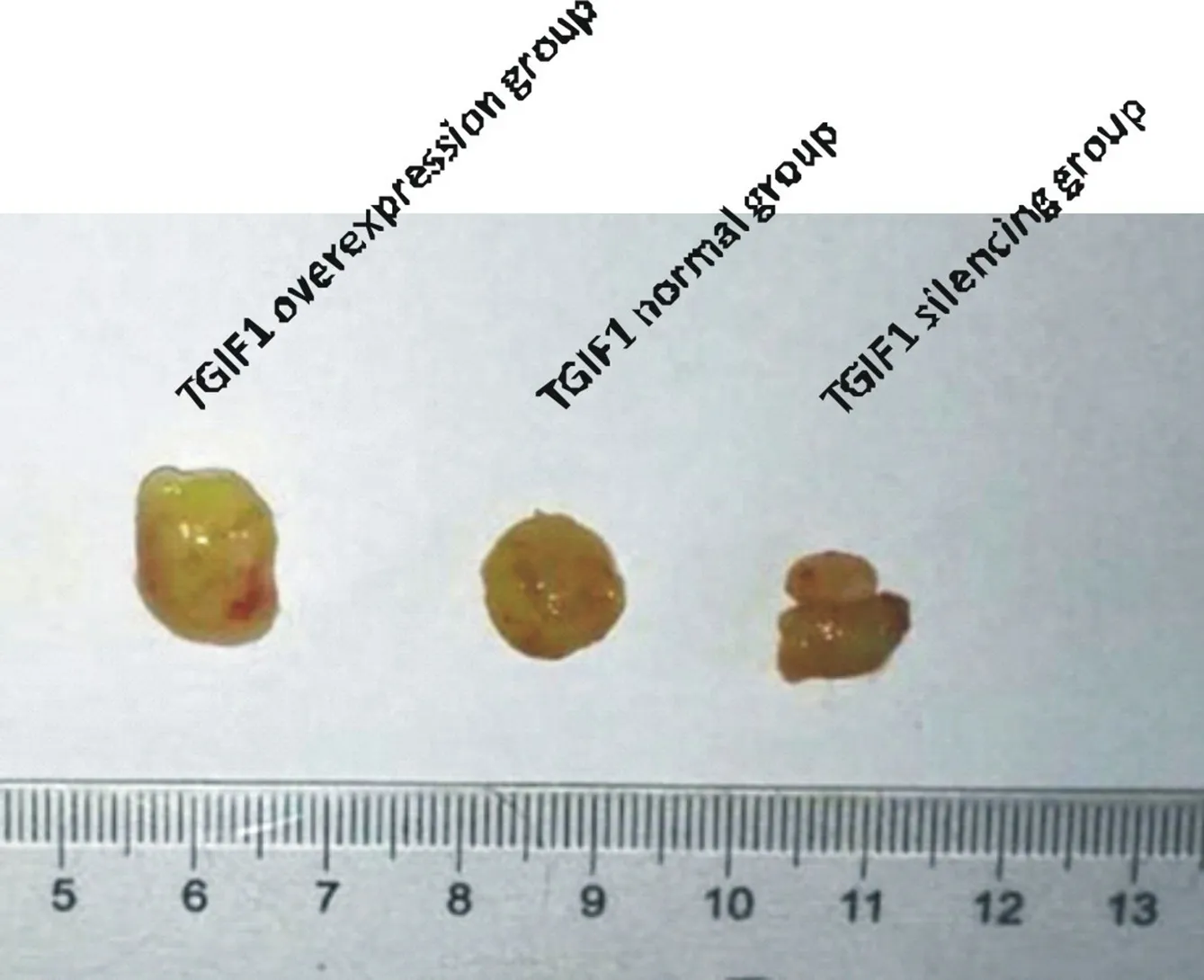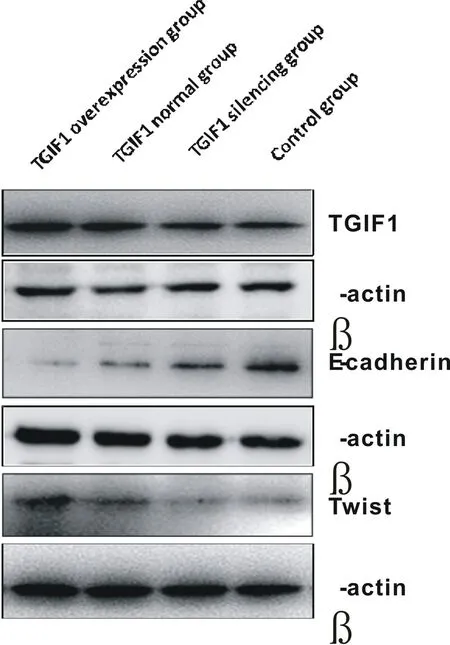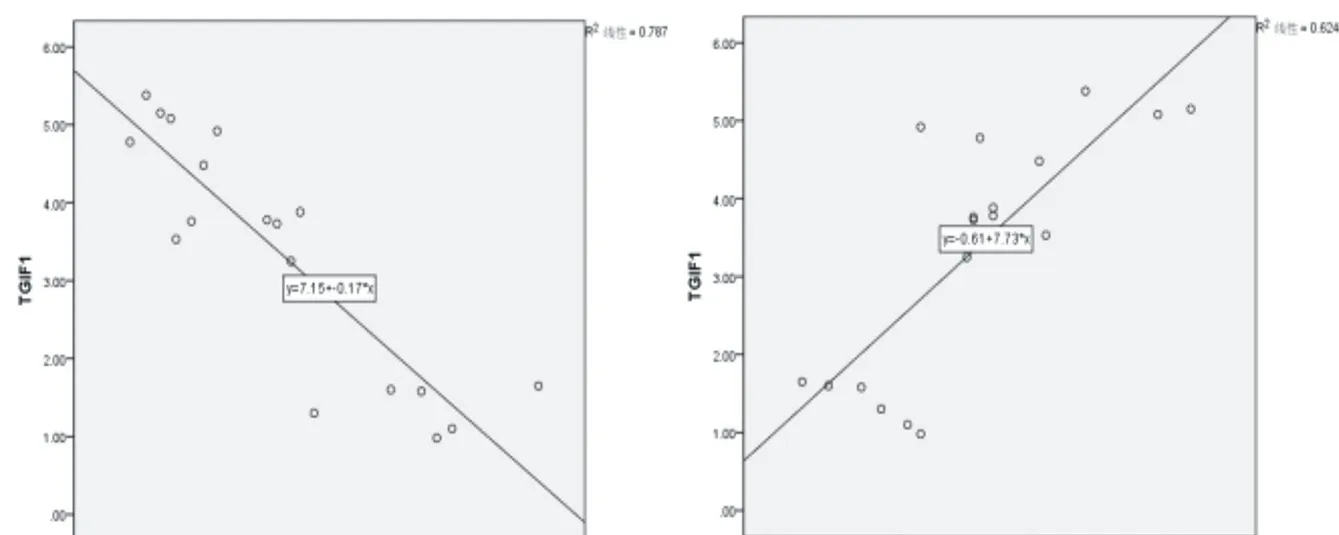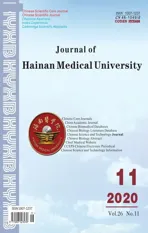Effect of TGIF1 expression on epithelial cadherin and Twist1 protein expression in breast cancer cells
2020-07-31YingLiuRuLiQiaoLiShangFengJunZhangQingLiZhao
Ying Liu, Ru-Li Qiao, Li Shang, Feng-Jun Zhang, Qing-Li Zhao
Department of Mammary Diseases, No.940 Hospital of Joint Logistics Support Force of People's Liberation Army, Gansu Lanzhou 730050, China
Keywords:Breast cancer TGIF1 E-cadherin Twist1 Expression level
ABSTRACT Objective: To observe the effect of the expression of transforming growth factor β-homologous inducible factor 1 (TGIF1) on the expression of epithelial cadherin (E-cadherin) and human Twist-related protein 1 (Twist1) in breast cancer cells. Methods: Total of twenty-four 6-weekold female SPF Balb/c mice were randomly divided into a control group, a TGIF1-silencing group, a TGIF1-normal group, and a TGIF1-overexpression group. In the TGIF1-silencing group, 4T1 breast cancer cells were interfered by lentivirus shRNA (H) lentiviral particles (sc-36659-v) to construct a breast cancer model. TGIF1-normal group used breast cancer cells (4T1) to construct a mouse model of breast cancer. And the TGIF1-overexpression group used 4T1 breast cancer cells with TGIF1 overexpression to establish a mouse model of breast cancer. Determination of TGIF1, E-cadherin and Twist1 protein levels in breast tumor tissue of mice in each group. Results: The tumor volume of mice in the TGIF1-overexpression group was significantly larger than that in the TGIF1-normal group and the TGIF1-silencing group, and the differences between the groups were statistically significant (P <0.05).The expression levels of TGIF1 and Twist1 protein in TGIF1-normal group, TGIF1-silencing group, and TGIF1-overexpression group were significantly higher than those in control group, and E-cadherin was significantly lower than that in control group. The differences between groups were statistically significant (P <0.05).The expression level of TGIF1 and Twist1 protein in TGIF1-silencing group was significantly lower than that in TGIF1-normal group, and E-cadherin was significantly higher than that in TGIF1-normal group (P < 0.05).The expression levels of TGIF1 and Twist1 proteins in the TGIF1-overexpression group were significantly higher than those in the TGIF1-normal group, and E-cadherin was significantly lower than that in the TGIF1-normal group. The differences between the groups were statistically significant (P <0.05). Pearson correlation analysis showed that the expression level of TGIF1 in breast cancer tissue was significantly negatively correlated with the expression level of E-cadherin protein, and was significantly positively correlated with the level of Twist1 protein (P <0.05). Conclusion: TGIF1 can affect the metastasis and invasion of breast cancer by regulating E-cadherin and Twist1 to interfere with the EMT pathway, which deserves further study.
1. Introduction
At present, breast cancer, as one of the global diseases, poses a serious threat to women's health and life safety. Proteomics is an important basis for judging biological behavior of breast cancer and guiding clinical treatment[1]. TGFβ-induced factor homeobox 1 (TGIF1) is one of the members of the three amino-acid extension (TALE) family of atypical homologous domain, which is closely related to many signal pathways and participates in the occurrence and development of tumors[2]. E-cadherin and Twist1 are closely related to the metastasis and invasion of a variety of malignant tumors[3-4]. It has been reported that inhibiting the expression of TGIF1 can reduce the migration and infiltration of breast cancer cells, but the specific mechanism is not clear[5]. In order to further clarify the mechanism of TGIF1 in breast cancer, the effect of the expression level of TGIF1 on the expression of E-cadherin and Twist1 protein in breast cancer cells was studied, so as to further clarify the role and pathway of TGIF1 in breast cancer. The report is as follows:
2. Materials and Methods
2.1 Animal Source and Grouping
Total of twenty-four 6-week-old SPF grade Balb/c female mice were purchased from Beijing Vital River Laboratory Animal Technology Co., Ltd. (License: SCXK2019-0006[Beijing]), with a weight of 18~22g and an average of (20.43 ± 0.86) g. They were randomly divided into control group, TGIF1-silenceing group, TGIF1-normal group and TGIF1-overexpression group. 4T1 was purchased from the National Infrastructure of Cell Line Resource.
2.2 Main Reagents and Instruments
Main Reagents: 1640 medium, 10% Fetal bovine serum, Trypsin EDTA, BCA Protein concentration test kit, Protein lysate and Phosphate buffer were purchased from Abcam. Fugene 6 transfection Kit (Promega), Purinomycin, Lentivirus particle TGIF shRNA, G418 kit, E-cadherin and Twist1 antibody were purchased from Santa Cruz biotechnology company (USA).
Main instruments: Bechtop , Microscope, Microsampler, Draught drying cabinet, 5%CO2 incubator, Magnetic stirrer, Analytical balance, Microplate system, Electrophoresis apparatus, UV gel imaging analysis system.
2.3 Methods
2.3.1 Cell Culture
Both the 4T1 cells and the 4T1 breast cancer cells with TGIF1 overexpression constructed by non-liposome transfection were cultured in 1640 medium with 10% fetal bovine serum, and then cultured in 37℃ and 5% CO2incubator. The culture medium was changed once every 2 days. The cells were trysinized and subcultured, and logarithmic growth cells were taken for in-situ inoculation in mice.
2.3.2 TGIF1 Plasmid Transfection and Screening
4T1 cells were cultured routinely. When the cells are cultured to 80% fusion state, TGIF1 plasmid transfection and lentivirus particle TGIF shRNA interference are carried out. The specific operation is carried out according to the corresponding kit. After the completion, the cells are added to 4T1 cell culture medium at room temperature for 20 minutes, cultured in 37℃ and 5% CO2incubator for 24 hours. After the medium is replaced, the TGIF1 overexpression screening is carried out with G418 kit, and the operation is carried out according to the instructions of G418 kit. Lentiviral granulosa TGIF shRNA interfered with 4T1 cells. Purinomycin screening was carried out, and the expression level of TGIF1 was detected by Western blot.
2.3.3 Model Construction
4T1 breast cancer cells (cell viability > 95%) in logarithmic phase were taken to prepare cell suspension with cell concentration no less than 1*107/ml. The mice in the TGIF1-normal group were injected with 0.2ml 4T1 breast cancer cell suspension in the left abdomen, the mice in the TGIF1-silencing group were injected with 0.2ml 4T1 breast cancer cell suspension interfered by TGIF shRNA (sc-36,659-V) in the left abdomen, the mice in the TGIF1-overexpression group were injected with 0.2ml of TGIF1 overexpressed 4T1 breast cancer cell suspension in the left abdomen, and the mice in the control group were injected with 0.1ml normal saline in the left abdomen. When the tumor was about 5-8 mm after 5-7 days, the mice in each group were killed and dissected.
2.3.4 Protein Expression
After dissecting the breast tumor tissues of mice in each group, the protein content was determined according to the instructions of BCA protein concentration test kit. After the completion, the protein concentration of each sample was adjusted, and the concentration of each sample was kept consistent for protein electrophoresis and imaging.
2.4 Observation Indicators
(1) The tumor volume of three groups of mice with breast cancer was measured by the same researcher and another researcher reviewed and recorded. Specifically, the tumor volume (mm3)=1/ 2ab2, a was the longest diameter of the tumor andbwas the width of the tumor. (2) The expression levels of TGIF1, E-cadherin and Twist1 in tumor tissues of mice in each group were observed; (3) Pearson correlation analysis was used to observe the expression levels of TGIF1, E-cadherin and Twist1.
2.5 Statistical Analysis
SPSS22.0 was used for statistical data analysis. The mean ± standard deviation (x±s)was used for measurement data. T-test was used for comparison between the two groups. One-way ANOVA was used to analyze all experimental data. The counting data were expressed by rate or percentage, and χ2test was used. The correlation of TGIF1, E-cadherin and Twist1 protein expression was analyzed by Pearson correlation. P < 0.05 was statistically significant.
3. Results
3.1 Comparison of tumor volume among three groups of mice with breast cancer
The results showed that the tumor volume of the TGIF1-normal group was (91.53 ± 6.72) mm3, the TGIF1-silencing group was (22.49 ± 4.38) mm3, the TGIF1-overexpression group was (147.64 ± 9.46) mm3, the difference between the groups was statistically significant (F = 14.306, P = 0.000).

Figure1 Tumor volume of 3 groups of breast cancer mice
3.2 Comparison of expression levels of TGIF1, E-cadherin and Twist1 in mice of each group
The results showed that the expression level of TGIF1and Twist1 protein in TGIF1-normal group, TGIF1-silencing group and TGIF1-overexpression group was significantly higher than that in the control group, E-cadherin was significantly lower than that in the control group, and the difference between the groups was statistically significant (P < 0.05); the expression level of TGIF1 and Twist1 protein in TGIF1-silencing group was significantly lower than that in TGIF1-normal group, E-cadherin was significantly higher than that in TGIF1-overexpression group, and the difference between the groups was statistically significant (P < 0.05); The expression level of TGIF1 and Twist1 in TGIF1-overexpression group was significantly higher than that in TGIF1-normal group, and E-cadherin was significantly lower than that in TGIF1-normal group (P < 0.05). See Table 1 and Figure 2.Group n TGIF1 E-cadherin Twist1

Table 1 Comparison of expression levels of TGIF1, E-cadherin and Twist1 in tumor tissues of each group(x±s)

Figure 2 Expression levels of TGIF1, E-cadherin and Twist1 in mammary gland tissues of each group
3.3 Correlation analysis of TGIF1, E-cadherin and Twist1 protein levels
The results showed that the expression of TGIF1 was negatively correlated with the expression of E-cadherin protein, and positively correlated with the expression of Twist1 protein (P < 0.05). See Table 2 and figure 3.

Table 2 Correlation between TGIF1 and E-cadherin, Twist1 levels

Figure 3 Pearson correlation analysis of TGIF1 and E-cadherin and Twist1 protein levels
4. Discussion
Breast cancer is one of the malignant diseases that seriously threaten women's health[6]. The early detection of breast cancer is not difficult, and the survival rate within five years after the early operation is relatively high, but the recurrence and metastasis rate are still the key factors affecting the clinical and prognosis. Moreover, the 5-year survival rate of patients with metastatic breast cancer is less than 30%[7], which seriously threatens the quality of life and safety of patients.
In recent years, the mechanism of breast cancer metastasis has made great breakthrough in genomics and proteomics with the deepening of research. At present, many studies have reported that the proliferation, metastasis and infiltration of breast cancer are related to a variety of protein factors [8-10]. Bi et al.[11]indicated in their study that more than 80 genes related to increased expression in invasive ductal carcinoma of the breast have been recognized, and there are still a large number of unidentified genes and proteins related to the proliferation, invasion and metastasis of breast cancer. TGIF1 has been confirmed to be up-regulated in malignant tumors such as lung cancer [12], rectal cancer [13], pancreatic cancer [14-15], and breast cancer [16], and is closely related to the proliferation, metastasis and invasion of tumor cells. In this study, the expression level of TGIF1 in breast cancer mice was significantly higher than that in control mice, and the tumor volume of mice in the TGIF1-overexpressed group was significantly higher than that in the TGIF1-normal group and the TGIF1- silencing group, which further confirmed that TGIF1 plays an important role in breast cancer. However, the mechanism of TGIF1 in breast cancer is still not completely clear, and there are few studies on the mechanism of TGIF1 in breast cancer at home and abroad, so it is of practical clinical significance to further clarify the role and mechanism of TGIF1 in breast cancer.
It is clear that E-cadherin and Twist1 are closely related to the metastasis and invasion of breast cancer. E-cadherin is a kind of transmembrane glycoprotein, which maintains cell polarity and integrity through adhesion between cells and matrix, and participates in epithelial mesenchymal transition (EMT), However, EMT plays a key role in the process of tumor metastasis, and it has been proved that the absence of E-cadherin is positively correlated with tumor invasion and metastasis[17-18]; Twist1 is also a key regulator in the process of EMT, and Twist1 participates in the upstream synthesis of E-cadherin as a transcription factor. Over expressed Twist1 can inhibit the expression level of E-cadherin and promote the invasion and metastasis of tumor cells, Some scholars have confirmed that Twist1 can promote the invasion and metastasis of breast cancer[19-20]. In this study, the expression level of Twist1 protein in the three groups of breast cancer mice was significantly higher than that in the control group, and E-cadherin was significantly lower than that in the control group, which was consistent with the above conclusions. In addition, the expression level of TGIF1and Twist1 protein in TGIF1-silencing group was significantly lower than that in TGIF1-normal group, E-cadherin was significantly higher than that in TGIF1-normal group, the expression level of TGIF1 and Twist1 protein in TGIF1-overexpression group was significantly higher than that in TGIF1-normal group, E-cadherin was significantly lower than that in TGIF1-normal group. Pearson correlation analysis results showed that the expression level of TGIF1 in breast cancer tissues was negatively correlated with the expression level of E-cadherin and positively correlated with Twist1, suggesting that TGIF1 could interfere with EMT pathway by regulating E-cadherin and Twist1 to affect the metastasis and invasion of breast cancer, which needs to be further confirmed.
There are some limitations in this study. This study analyzes the effect of TGIF1 expression level on the expression of E-cadherin and Twist1 in breast cancer cells through basic experiments to confirm its role and related mechanism in breast cancer. However, due to the small number of samples and the lack of further study on cell proliferation, the effect of TGIF1 expression level on the proliferation of breast cancer cells still needs to be further studied, which will be one of the key research contents of the author in the future.
杂志排行
Journal of Hainan Medical College的其它文章
- Experience of Professor Shao Mingxi in treating knee osteoarthritis based on "Bin Si Xue" acupuncture
- Establishment and evaluation of Type 2 Diabetes Mellitus andits complications induced by low dose of multiple streptozotocin
- Acupuncture for post-stroke dysphagia: An overview of systematic reviews
- Meta analysis of Masquelet technology and Llizarov technology in the treatment of infectious bone defects
- Study on novel coronavirus pneumonia (COVID-19) mechanism by Huashi Baidu Formula based on network pharmacology
- A case of recurrent PMT caused by poor atrial pacing
